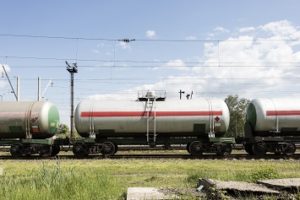Do you know your general service tank cars from your cryogenic liquid tank cars? Do you know your refrigerated liquefied gases from your liquefied compressed gases? If your facility handles hazardous materials in tank cars, you should!

????? ??????? / iStock / Getty Images Plus / Getty Images
If you could use a refresher, you may want to look up the 2017 Field Guide to Tank Cars, available as a free download from the Association of American Railroads. Here’s a look at what the updated Guide covers.
Tank Car Types
In general, there are three categories of tank cars. Each type of tank car is discussed in detail in its own section of the field guide:
- Nonpressure tank cars. In the 2016 Emergency Response Guidebook, these are labeled “general service” or “low-pressure” tank cars. These cars may transport many different regulated (e.g., hazardous materials and dangerous goods) and nonregulated solids and liquids. The term “nonpressure” can be misleading; these tanks may have built-up internal tank pressure and should be handled with care.
- Pressure tank cars. These tank cars have thicker tanks, and they can withstand higher internal pressures than nonpressure tank cars. They are used to transport liquefied compressed gases, materials that are poison/toxic inhalation hazards, reactive materials, and some corrosives.
- Cryogenic liquid tank cars. These vacuum-insulated tank cars have an inner container (tank) with a carbon steel outer shell (tank, not jacket). They transport refrigerated liquefied gases, including liquid hydrogen, ethylene, oxygen, nitrogen, and argon, that have boiling points below minus 130°F at atmospheric pressure.
The tank car classification and specifications must be clearly stenciled on both sides of the car; a guide to the classification markings, as well as other stenciling required on tank cars, can also be found in the field guide.
Safety Systems
Safety systems on tank cars are designed to protect the tanks and fittings in the event of accidents and impacts. Devices discussed in the field guide include:
- Pressure relief devices (PRD), which are required for tank cars transporting certain types of hazardous materials
- Coupler vertical restraint systems (double-shelf couplers), which prevent couplers from separating and reduce the risk of tank car head punctures
- Tank head puncture-resistance systems (head shields), additional shielding that also reduces the risk of tank car head punctures
- Thermal (fire) protection systems, which prevent releases from tanks exposed to fire
- Other protection systems
Emergency Response
Basic emergency response procedures are discussed in the field guide, including:
- Initial notification. There is a list of contact numbers for all major rail carriers.
- Accident assessment. The field guide recommends using binoculars to assess matters from a safe distance.
- Identification of materials. This can be done using documents carried on the train or by contacting the rail carrier.
- Tank car damage assessment. This is a preliminary assessment that is used to help determine what action should be taken.
Look Yonder, Comin’ Down That Railroad Track
Changes to tank cars are coming down the track. In May 2015, the U.S. Department of Transportation (DOT) established a new tank car specification, “DOT 117A100W,” that will be required for the transportation of all Class 3 flammable liquids. Beginning in January 2018, the use of existing Class DOT-111 (“legacy tank cars”) and CPC-1232 tank cars will be phased out in favor of the newer model.
Complete phaseout schedules are included in the field guide.
